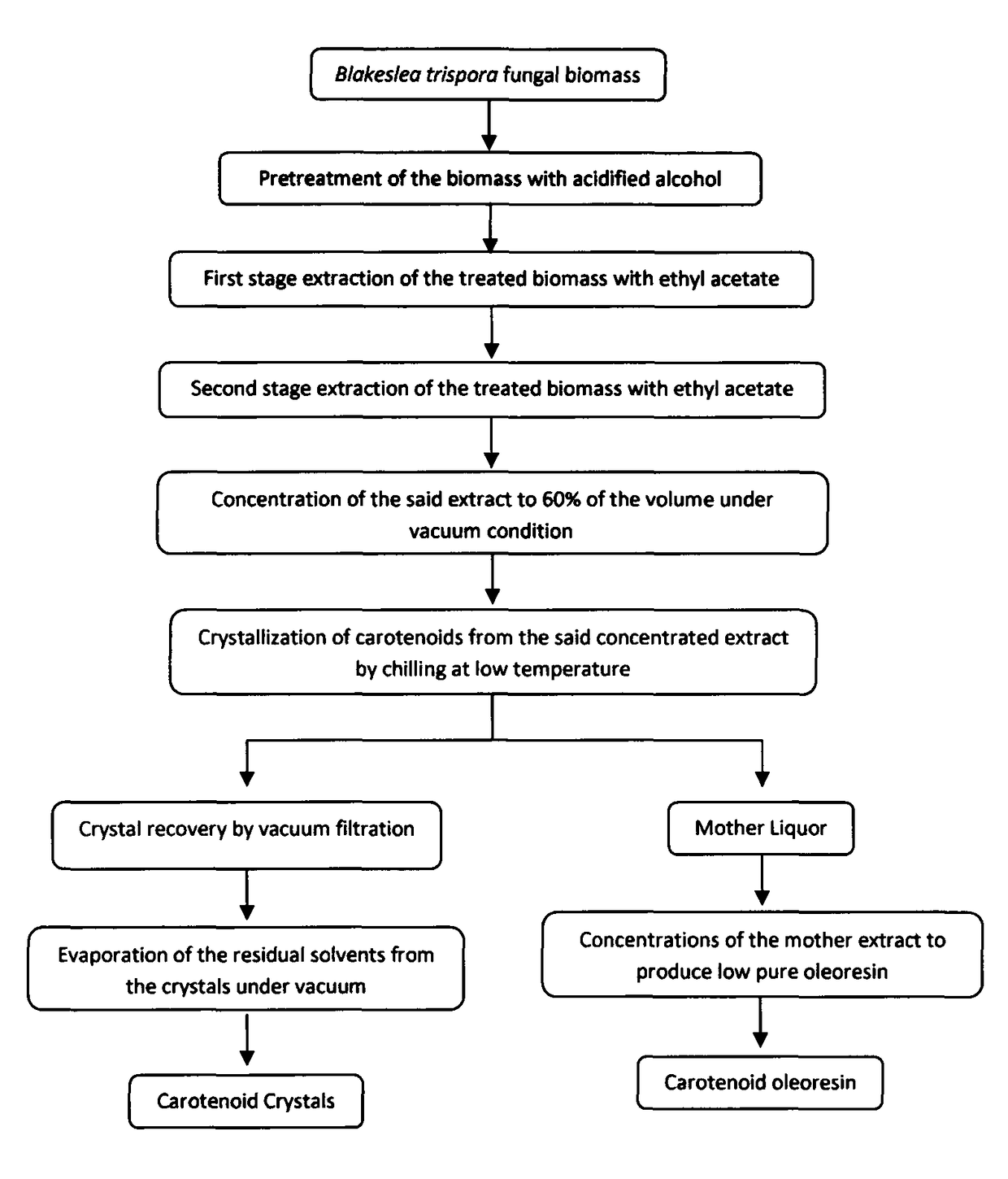Process for production of high purity beta-carotene and lycopene crystals from fungal biomass
a technology of lycopene and crystals, which is applied in the field of microbially produced carotenoid compounds, can solve the problems of loss of lycopene, loss of beta-carotene, and complex process of using multiple solvents for extraction and precipitation steps, and achieves the effect of simple and cost-effectiv
- Summary
- Abstract
- Description
- Claims
- Application Information
AI Technical Summary
Benefits of technology
Problems solved by technology
Method used
Image
Examples
examples 1
[0049]50 gms of Blakeslea trispora biomass containing 62.20 gms / kg of beta-carotene is loaded into 0.5 liter capacity round bottomed flask with an agitator, To this 150 ml of acidified ethanol with 2% acetic acid in ethanol is added at room temperature of 35 deg C., then this mixture is stirred for 30 min. Once the treatment is completed, the treated mixture is vacuum filtered to yield 53.4 Gms of biomass. Then the treated biomass is transferred into 5 liter capacity round bottomed flask, to which 1000 ml of ethyl acetate is added. This mixture is homogenized for an hour under stirring at a temperature of about 50 deg C. in hot water bath system. After one hour, the mixture is vacuum filtered to give 47.3 gms of extracted biomass and 980 ml of Mother liquor. The Mother liquor is kept stored for further beta-carotene recovery. Then the extracted biomass is taken for second extraction with 500 ml of ethyl acetate at the same conditions like the first extraction. After second extractio...
examples 2
[0050]50 gms of Blakeslea trispora biomass containing 62.20 gms / kg of beta-carotene is loaded into 0.5 liter capacity round bottomed flask with an agitator, To this 150 ml of acidified ethanol with 2% acetic acid in ethanol is added at room temperature of 35 deg C., then this mixture is stirred for 30 min. Once the reaction is completed, the reaction mixture is vacuum filtered to yield 51.2 Gms of treated biomass. Then the treated biomass is then transferred into 5 liter capacity round bottomed flask, to which 1000 ml of ethyl acetate is added. This mixture is homogenized for an hour under stirring at a temperature of about 50 deg C. in hot water bath system. After one hour, the mixture is vacuum filtered to give 49.1 gms of extracted biomass and 988 ml of Mother liquor. The Mother liquor is stored for further beta-carotene recovery. Then the extracted biomass is taken for second extraction with 500 ml of ethyl acetate at the same conditions like the first extraction. After second e...
examples 3
[0051]500 gms of Blakeslea trispora biomass containing 62.20 gms / kg of beta-carotene is loaded into 5.0 liter capacity round bottomed flask with an agitator, To this 1500 ml of acidified ethanol with 2% acetic acid in ethanol is added at room temperature of 35 deg C., then this mixture is stirred for 30 min. Once the reaction is completed, the reaction mixture is vacuum filtered to yield 518.0 Gms of treated biomass. Then the treated biomass is then loaded into 15 liter capacity round bottomed flask, to which 10000 ml of ethyl acetate is added. This mixture is homogenized for an hour under stirring at a temperature of about 50 deg C. in hot water bath system. After one hour, the mixture is vacuum filtered to give 494.0 gms of extracted biomass and 9100 ml of Mother liquor. The Mother liquor is stored for further beta-carotene recovery. Then the extracted biomass is taken for second extraction with 5000 ml of ethyl acetate at the same conditions like the first extraction. After secon...
PUM
| Property | Measurement | Unit |
|---|---|---|
| temperature | aaaaa | aaaaa |
| temperature | aaaaa | aaaaa |
| temperature | aaaaa | aaaaa |
Abstract
Description
Claims
Application Information
 Login to View More
Login to View More - R&D
- Intellectual Property
- Life Sciences
- Materials
- Tech Scout
- Unparalleled Data Quality
- Higher Quality Content
- 60% Fewer Hallucinations
Browse by: Latest US Patents, China's latest patents, Technical Efficacy Thesaurus, Application Domain, Technology Topic, Popular Technical Reports.
© 2025 PatSnap. All rights reserved.Legal|Privacy policy|Modern Slavery Act Transparency Statement|Sitemap|About US| Contact US: help@patsnap.com

